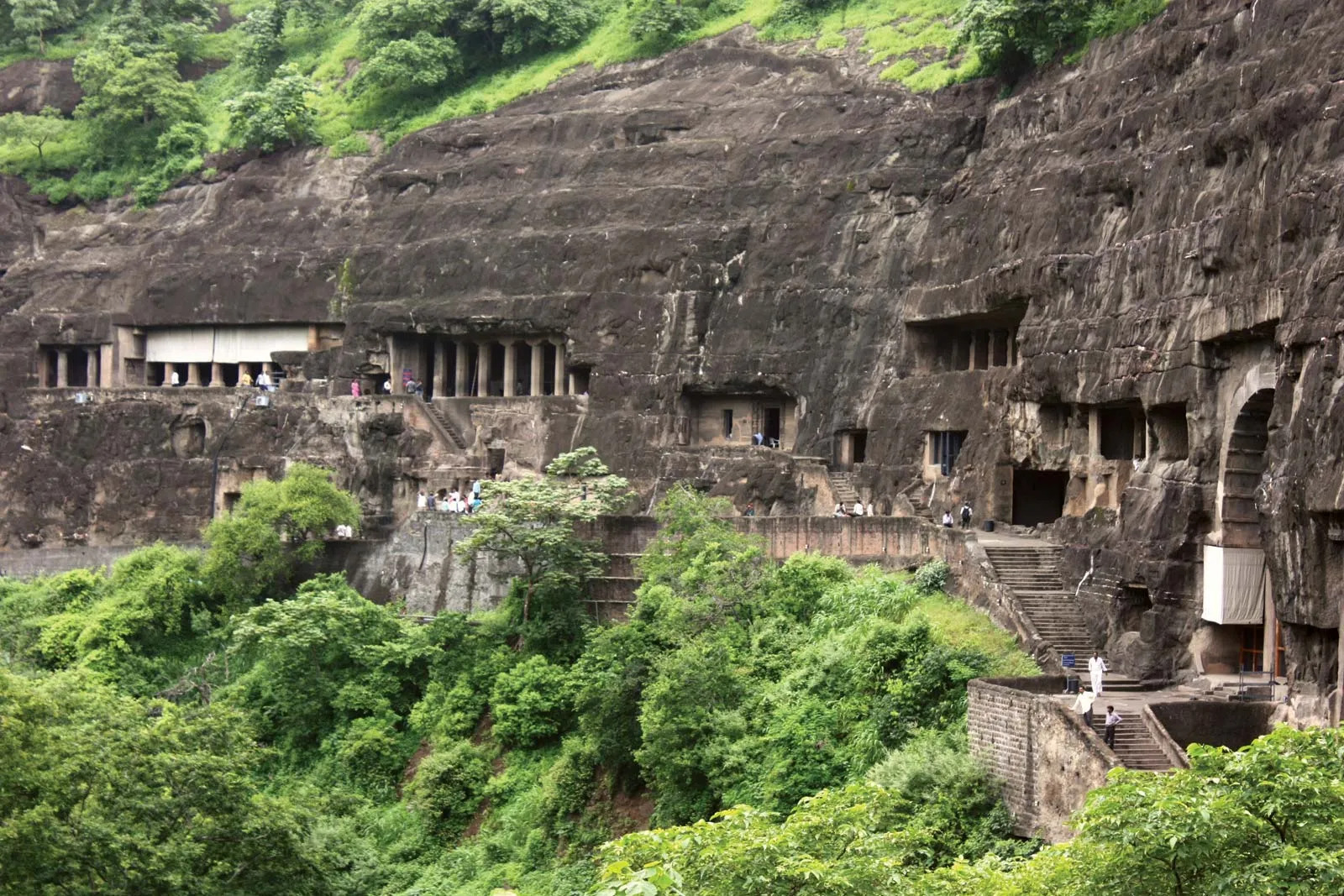
Ajanta Caves, located in the state of Maharashtra, India, is a UNESCO World Heritage Site and one of the most significant archaeological sites in the world. Dating back to the 2nd century BCE, these ancient Buddhist caves showcase remarkable architectural and artistic achievements. The site consists of 30 rock-cut caves adorned with exquisite paintings, sculptures, and elaborate carvings. The Ajanta Caves are not only a testament to the grandeur of ancient Indian civilization but also a window into the spiritual and cultural practices of the time. In this article, we will explore 11 fascinating facts about Ajanta Caves, shedding light on the historical significance and captivating beauty of this remarkable landmark.
Key Takeaways:
- The Ajanta Caves, a UNESCO World Heritage Site, showcase stunning paintings and intricate architecture dating back to the 2nd century BCE, offering a glimpse into ancient India’s rich cultural heritage.
- These ancient caves, carved into a horseshoe-shaped rock, served as monastic retreats for Buddhist monks and continue to inspire art and architecture worldwide, making them a popular tourist destination today.
The Ajanta Caves are a UNESCO World Heritage Site.
The Ajanta Caves, located in Maharashtra, India, are recognized as a UNESCO World Heritage Site since This prestigious designation signifies their outstanding universal value and cultural significance.
The caves date back to the 2nd century BCE.
The Ajanta Caves were initially carved out of the rock in the 2nd century BCE by Buddhist monks. Over the centuries, additional caves were added, resulting in a total of 30 rock-cut cave monuments.
The caves are renowned for their exquisite paintings.
One of the most remarkable features of the Ajanta Caves is the stunning paintings found on the cave walls. These intricate and detailed artworks depict scenes from Buddhist mythology and offer a fascinating insight into ancient India’s artistic heritage.
The caves were rediscovered in the 19th century.
After being abandoned for centuries, the Ajanta Caves were rediscovered in 1819 by a British officer named John Smith. The remarkable beauty and historical significance of the caves quickly gained international attention.
The Ajanta Caves are a masterpiece of ancient Indian architecture.
The architecture of the Ajanta Caves showcases the skill and craftsmanship of ancient Indian artisans. The caves feature intricate carvings, ornate pillars, and beautifully designed prayer halls that reflect the rich cultural heritage of the time.
The caves were used as monastic retreats.
The Ajanta Caves served as a place of refuge and meditation for Buddhist monks seeking solitude. These caves provided them with a serene and peaceful environment for spiritual reflection and religious practices.
The caves depict different Buddhist traditions.
The Ajanta Caves showcase a variety of Buddhist traditions and artistic styles. From Hinayana to Mahayana Buddhism, the caves offer a glimpse into the evolution and diversity of Buddhist practices during that era.
The Ajanta Caves have influenced art and architecture worldwide.
The artistic and architectural influence of the Ajanta Caves extends far beyond India. Their intricate paintings and innovative rock-cut architecture have inspired artists, architects, and scholars worldwide, leaving a lasting impact on the world of art and culture.
The caves were carved into the horseshoe-shaped rock.
The Ajanta Caves are situated in a horseshoe-shaped rock, with the river Waghora flowing through the middle. This natural formation provided a perfect canvas for the carving of these magnificent caves.
The caves are a testament to the ancient Indian belief in the pursuit of enlightenment.
The Ajanta Caves reflect the deep spiritual beliefs of ancient India. These caves were created as a place for monks and followers to seek enlightenment through the practice of Buddhism and the path to nirvana.
The Ajanta Caves are a popular tourist destination.
Today, the Ajanta Caves attract visitors from all around the world who come to marvel at the beauty and historical significance of these ancient cave complexes. They continue to be a symbol of India’s rich cultural heritage and a must-visit destination for history and art enthusiasts.
Conclusion
In conclusion, the Ajanta Caves are a true marvel of ancient Indian architecture and artistry. These caves have a rich cultural and historical significance, and offer a unique glimpse into the artistic brilliance of the past. From the stunning murals and sculptures to the intricate rock-cut architecture, there is no shortage of wonder at Ajanta.
Visiting the Ajanta Caves is like stepping back in time and immersing oneself in the beauty of an ancient civilization. The craftsmanship and attention to detail displayed in these caves are truly breathtaking, and highlight the artistic accomplishments of the ancient Indian artisans.
Whether you are a history enthusiast, an art lover, or simply curious about the wonders of the world, a visit to the Ajanta Caves is a must. These caves are not just landmarks, but living testaments to the incredible ingenuity and creativity of human beings throughout the ages.
So, plan your trip to Ajanta Caves and get ready to be captivated by their enchanting beauty and rich history.
FAQs
1. How old are the Ajanta Caves?
The Ajanta Caves date back to the 2nd century BCE and were used as a place of worship and meditation by Buddhist monks.
2. How many caves are there in Ajanta?
There are a total of 30 caves at Ajanta, each showcasing intricate carvings, murals, and sculptures.
3. Are the Ajanta Caves UNESCO World Heritage Sites?
Yes, the Ajanta Caves were designated as a UNESCO World Heritage Site in 1983 due to their exceptional cultural and historical significance.
4. Can visitors enter all of the caves?
No, only a few select caves at Ajanta are open for public viewing. The rest of the caves have been preserved and protected to maintain their historical integrity.
5. What is the best time to visit the Ajanta Caves?
The best time to visit the Ajanta Caves is during the winter months of November to February, when the weather is pleasant and conducive for exploration.
6. Are there any entry fees for visiting the Ajanta Caves?
Yes, there are entry fees for visiting the Ajanta Caves. The fees vary for Indian and foreign visitors, with additional charges for photography and videography.
7. Is there any accommodation available near the Ajanta Caves?
Yes, there are several accommodation options available near the Ajanta Caves, ranging from budget hotels to luxury resorts, to cater to the needs of all types of visitors.
Intrigued by the captivating history and artistic marvels of Ajanta Caves? Continue your exploration with our other enthralling articles. Delve deeper into the enigmatic aspects of this UNESCO World Heritage site, uncovering more fascinating facts that will leave you in awe. Discover the monastic complex's hidden treasures and gain a profound understanding of its significance in ancient Indian culture. Embark on a virtual journey through time as you unravel the mysteries surrounding these magnificent caves, each article offering a unique perspective on their timeless beauty and historical importance.
Was this page helpful?
Our commitment to delivering trustworthy and engaging content is at the heart of what we do. Each fact on our site is contributed by real users like you, bringing a wealth of diverse insights and information. To ensure the highest standards of accuracy and reliability, our dedicated editors meticulously review each submission. This process guarantees that the facts we share are not only fascinating but also credible. Trust in our commitment to quality and authenticity as you explore and learn with us.


